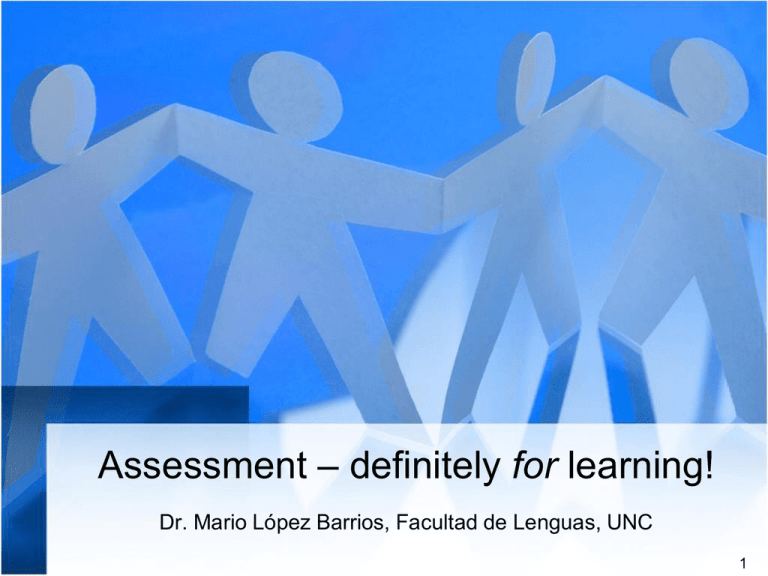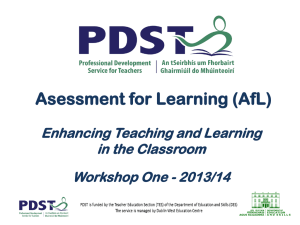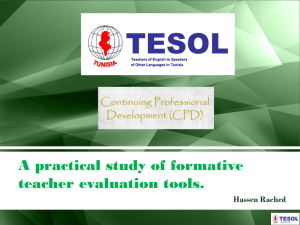Assessment – definitely for learning!
advertisement

Assessment – definitely for learning! Dr. Mario López Barrios, Facultad de Lenguas, UNC 1 A case: Juan’s story Juan is 15 and he’s a 3rd year student at an urban middle class private school. He’s not doing as good as he could because he invests very little time in homework and studying. His last maths test was on September 4th, his next one is tomorrow. Since yesterday he’s been cramming for it. He realizes he can’t cope with it on his own and takes a two-hour private class. With luck on his side he’ll get a passing mark – which is not enough to save him from sitting for the final exam in December. What happened to Juan between September 4th and today? 2 A case: Juan’s story September 4th Test October 3th Test Test results: Sept. 9th Test announced Sept. 30th Class activities: introduction of new topics, some review, an “oral lesson” • How can the teacher check the knowledge learners construct? • How can the learning effort be extended evenly throughout time (and not the day before the test)? • How does Juan ‘get the message’ that his performance is being monitored in between tests? 3 Assessment – definitely for learning! • Formative Assessment: Assessment for Learning (AfL) • Research evidence • Issues in classroom-based formative assessment • Implementing AfL in one’s own teaching practice 4 Assessment • Assessment should inform learning and teaching • “Assessment should be for leaning in classrooms and elsewhere, not just of learning, as in formal, standardized tests” (Cumming & Laurier, 2008) 5 Types and functions of assessment • • • • Formative assessment Summative assessment Diagnostic assessment Evaluative assessment assessment for learning assessment of learning 6 Assessment for learning (AfL) “Assessment for learning is any assessment for which the first priority in its design and practice is to serve the purpose of promoting pupils' learning. It thus differs from assessment designed primarily to serve the purposes of accountability or of ranking or certifying competence.” (Black & Jones, 2006) Assessment Reform Group (King’s College, London) 7 Assessment for learning (AfL) • Starting point: the determination of the pupils’ existing understanding of a topic Constructivism • Then the teacher uses the feedback to modify the teaching plan learning cannot be done for learners, it has to be done by them, albeit with the teacher supporting any new input (Black & Jones, 2006) 8 Assessment for learning (AfL) “Feedback is only formative if it brings about a change of some kind for the learner. This implies a change in the level of awareness of a learner about language, or a change in an individual’s language development or language use in some way” (Rea-Dickins 2006) 9 Crucial features of AfL • The provision of effective feedback • The active involvement of pupils in their own learning • Adjusting teaching to take account of the results of assessment • A recognition of the influence of assessment on motivation and self-esteem • The need form pupils to be able to assess themselves to to understand how to improve (Neil Jones 2007, ALTE Conference Vilnius) 10 Formative and summative assessment • Functions of assessment: – Scriven (1967) summative and formative program evaluation – Bloom, Hastings & Madaus (1971) extend the differentiation to various forms of assessment (Stiggins 2005) 11 Formative and summative assessment • Formative assessment evaluates students in the process of “forming” their competencies and skills with the goal of helping them to continue the growth process. The key to such formation is the delivery (by the teacher) and internalization (by the student) of appropriate feedback on performance, with an eye toward the future continuation (or formation) of learning. • Summative assessment aims to measure, or summarize, what a student has grapsed, and typically occurs at the end of a course or unit of instruction. A summation of what a student has learned implies looking back and taking stock of how weel that student has accomplished objectives, but does not necessarily point the way to future progress. Final exams in a course and general proficiency exams are examples of summative assessment. (Brown 2004) 12 Research findings of AfL • Black & William (1998): FA can raise standards of pupil achievement • Rea-Dickins & Gardner (2000): what do teachers understand under formative assessment? • Gattullo (2000): recurrent FA processes in an Italian EFL class for YLs • Rea-Dickins (2001): stages in teacher assessment cycle, FA strategies employed by teachers of EAL • Rea-Dickins (2006): ways in which learners engage in formative assessment (instructionembedded assessment) 13 Specific L2 issues in formative assessment Leung & Lewkowicz (2006) point out three main issues: • The interpretation of assessment criteria on the part of teachers • Compatibility of formative assessment with local educational requirements • In theory, teachers [and learners] readily adopt AfL, in practice, they may resist its implementation 14 Possible implementations of AfL • • • • • Questioning and dialogue Feedback on written work Self- and peer-assessment Formative use of summative tests Learning together – learning from others (Black and Jones 2006) 15 Questioning and dialogue Rationale: • ongoing multi-phase process that is carried out on a daily basis through teacher-pupil interaction • provides feedback for immediate action • aims at modifying teaching activities in order to improve learning processes and results (Gattullo 2000, 279) 16 17 Recurrent categories of assessment processes A. B. C. D. E. F. G. H. I. Questioning / eliciting Input, Response and Feedback Correcting cycle (IRF) Judging Rewarding Observing process Examining product Clarifying Task criteria Metacognitive questioning (Gattullo 2000, 281) 18 Examples of questioning and dialogue • Concept questions • Consciousness raising (CR) • Checking results of activities 19 Concept questions • Questions asked to check if learners understand the meaning of a (newly introduced) language item • Example To test understanding of the use of 'used to' in the example 'I used to swim in the summer', a teacher might ask 'Do I still swim now?' and 'Did I only swim once?' to test understanding of 'used to' as a finished and repeated action in the past. (teachenglish knowledge wiki) 20 Students will become familiar with ‘there is’ and ‘there are’ to express existence Concept questions T: Where are we? At home? Is this the canteen? T: (pointing to the window) What’s this? (pointing to the chairs) And what are these? T: Look. In the classroom there’s a window, there’s a blackboard and there’s a table. There are 40 chairs, there are 3 maps (etc. etc.) T: There’s a blackboard, there are 40 chairs. What’s the meaning of there’s, there’s a blackboard in the classroom, there’s a map in the classroom, there are 40 chairs? T: Yes, excellent! Now listen to me and repeat: there’s a blackboard … Rewarding T: Look at me: /ðerzə ‘blækbɔ:d/, you see me? (pointing at the tip of the tongue). Repeat /ðerzə ‘blækbɔ:d/ SS: No, we are at school. No, it’s the classroom. SS: It’s a window. These are chairs. SS listen to the description. SS: ¿Que hay un pizarrón? / ¿Haber?, etc. hypothesis Questioning / eliciting SS repeat SS: /ðerzə ‘blækbɔ:d/ 21 Concept questions T: (after having compared a Fiat 600 and a Ferrari using bigger/smaller, cheaper, faster/slower, older/newer). What is the meaning of ‘smaller’, ‘The Fiat 600 is smaller than the Ferrari’? SSS: Más chico, que es más chico que la Ferrari. T: Right! And cheaper? Listen: The Fiat 600 is cheaper than the Ferrari. SSS: ¿Que es más barato? ¿Qué cuesta menos que la Ferrari? 22 Concept questions T: (after having presented a dialogue between Patito and Antonella talking about their holiday plans). Patito says: I’m going to La Cumbre with my family and my dog Matías next month. ¿Se va ahora a La Cumbre? Listen: (T repeats the sentence). SSS: No, en las vacaciones de invierno / el mes que viene. T: Yes, very good! And Antonella? 23 Concept questions • What aspects are related to concept checking? • When will the aspects of form be clarified? (for example, the fact that English has two forms (there’s, there are) and Spanish only one (hay). • Is a distinction between different meanings relevant for this structure? • Is a distinction of use relevant for this structure? 24 Consciousness raising • Guided discovery: “An alternative to giving explanations would be to create activities that allow learners to generate their own discoveries and explanations. Tasks at just the right level will draw attention to interesting language issues. Teacher questions (and use of other techniques) will ‘nudge’ learners towards key points. In this way, long explanations can be avoided and learners take a more active role in their own progress”. (Scrivener 2005, 268) 25 26 EO: Students will discriminate between gerunds and infinitives T: (after she listens to SS’s answers, T draws SS’s attention to the first SS answer the questions sentence and asks SS) What is the main verb in this question? What SS: ‘an infinitive’ Response comes after the verb? An –ing form or Questioning / eliciting an infinitive? T: ‘right, an infinitive. Remember after verbs such as need, want and try we Reward use the ‘to infinitive’. Clarifying … Learning? T then explains that ‘ing forms’ are Clarifying formally called ‘gerunds’. In order to make it clear, T recapitulates the main points by saying: ‘then we use Clarifying gerunds after verbs such as like, enjoy, etc.; we use them also after prepositions such as from, at, etc. and as the subject of a phrase or sentence’ 27 Guided discovery Look at the verbs in the questions and Teacher observes the process, examines match: Verbs the product, corrects, clarifies, uses metacognitive questioning What kinds of verbs follow In these cases? a) gerund b) ‘to infinitive’ • after need, want, try • after like, hate, love • after an adjective (for example it is difficult, I find it good, etc.) • to express purpose or reason • subject of a phrase or sentence Learners observe, classify, verify or correct hypotheses, engage actively in the learning process, get feedback and opportunities for clarification After this, learners may verify their findings using the grammar reference 28 Checking results of activities When checking the answers to an exercise or activity teachers often revert to a more traditional role, whereby from the front of the room they ask students for their answers and tell them whether they are right. However, in the student-centred classroom this important stage in the learning process could be better exploited so as to be more engaging, interactive and empowering for our learners. www.teachingenglish.org.uk 29 Checking results of activities Metacognitive questioning Learners verify or correct choices, engage actively in the learning process, get feedback and opportunities for clarification New English File Elementary EO: Students read a text for general information … Now T SS read tells SS to the text read the and two texts decide silently the and to women’s decide nationawhere lity. the women come from (Rio, Beijing or Moscow). SS say the T points answers to individual and SS to say justify their their answers choice (ex. I and to think justify Sabina their lives in choice. Rio because …) 30 Epilogue: Recapping Juan’s story • Changing Juan’s learning habits • What does this imply for him? – Maximizing his learning through FA – Active involvement in his own learning – Raising his self-esteem • What does this imply for his teachers? – Implementing FA in class – Switching to more interactive forms of teaching – Support of learning outside class 31 References Rea-Dickins, Pauline (2006) Currents and eddies in the discourse of assessment: a learning-focused interpretation. International Journal of Applied Linguistics 16/2,163-188 Black, P. and J. Jones (2006) Formative assessment and the learning and teaching of MFL: sharing the language learning road map with the learners. Language Learning Journal 34, 4-9. Cumming, A. and M. Laurier (2007) 'Introduction to the Special Issue'. Canadian Modern Language Review 64/1: 1-4. Jones, N. (2007) Linking learning and assessment: a can-do framework. ALTE Conference Vilnius. http://www.alte.org/further_info/vilnius/nj091107.pdf Stiggins, Rick (2005) From Formative Assessment to Assessment FOR Learning: A Path to Success in Standards-Based Schools, Phi Delta Kappan, Vol. 87, No. 04, December 2005, pp. 324-328. http://www.assessmentinst.com/forms/FromFormat_k0512sti.pdf Brown, H. D. (2004) Language assessment. White Plains, NY: Longman. Rea-Dickins, P. and S. Gardner (2000): Snares and silver bullets: disentangling the construct of formative. Language Testing 17; 215-243 Gattullo, F. (2000) 'Formative assessment in ELT primary (elementary) classrooms: an Italian case study'. Language Testing 17; 278-288. Rea-Dickins, P. (2001)'Mirror, mirror on the wall: identifying processes of classroom assessment'. Language Testing 18; 429-462. Leung, C. and J. Lewkowicz (2006) Expanding horizons and unresolved conundrums: language testing and assessment. TESOL Quarterly 40, 211-234. 32




